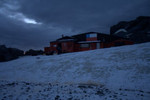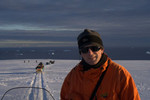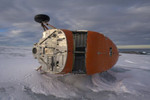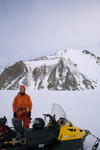To Carvajal and back
April 14th, 2006So, the six of us went to Carvajal, in glorious weather! A week’s sustained good weather is unusual anywhere, but down here it’s especially valued.
The six of us consisted of three trippers (myself, Mark and Jade) and three field assistants (Soup, Bruce and Tom), and we travelled and camped in three pairs. The system for travel and camping has been worked out by BAS over the years, and involves a lot of equipment, which is carried on two wooden Nansen sledges, towed by skidoos. The FGA rides the lead skidoo, towing the “half-unit” sledge, which contains just emergency survival gear. The half-unit is then linked by a 30m rope to the second ‘doo, which in turn tows the “full-unit” sledge which has all the equipment for day-to-day camping on it. The idea is that if you need to do a day trip from your campsite you can leave the full-unit behind and just take the half-unit, which is enough to survive with if you got caught in bad weather. Riding the rear skidoo is quite tricky, as you have to keep the long link-line taught enough that you don’t run over it, but slack enough that you don’t drag behind the lead skidoo. Needless to say, this takes a bit of practice!

Two skidoos and two sledges – the lead doo is the one nearer the camera. Note the long link-line attached to the front of the second doo

Sledges: the half-unit is nearer the camera.
Anyway, we left Rothera on an overcast day, using both skidoos to tow the heavily laden full-unit up to the caboose, where we dug out the half-unit (it had become buried in snow – this happens a lot) and set up for the journey ahead. We drove on for about an hour to Trident, the mountain that marks the approach to McCallum’s Pass – the access to the rest of the island. McCallum’s is the point where winter trips tend to come unstuck – the pass itself and the Shambles Glacier beyond it are prone to crevassing, so you only travel through that area on bright clear days when you have what we call good contrast – you can see features in the snow easily. We had very poor contrast, so we encamped for the night and then set off for a gentle stroll up a small nunatak on the end of Trident. This gentle stroll turned out to be slightly harder than I’d expected, but mostly because I’d made two schoolboy errors. Firstly, I was wearing too many clothes and got hot and sweaty and had to stop and take off a layer, and secondly I failed to check my rucksack properly and only later realised that I’d dragged 30m of heavy climbing rope up the nunatak unnecessarily!
Camping in the Antarctic is done in Pyramid tents, which are very wind-resistant. They’re quite spacious and comfortable inside for two people. You cook inside on a Primus stove, and have a paraffin “Tilley” lamp that provides light and heat. To keep you warm whilst you sleep, you have the BAS Sleeping System (more commonly known as the P-Bag – the prefix P is mostly used in BAS-speak to denote Personal) which consists of:
– a sleeping board that goes on top of the tent groundsheet
– a foam camping mat (“Karrimat” style)
– an inflatable camping mat (“Therm-a-Rest”)
– a sheepskin rug
– a polar-grade down sleeping bag, in a canvas cover to protect it from grease and fire.
You can also put a fleece liner in the sleeping bag to make it even warmer, although I’ve never met anyone who’s done this, as the bags are pretty warm as it is. I use my fleece liner as a pillow. Everything except the board rolls up inside a giant plastic-lined stuff-sack (the P-bag) which is carried on the full-unit sledge.
Anyhow, Day 2 dawned bright and clear, so we packed up (this takes 2 hours!) and drove up over McCallum’s and down onto the Shambles Glacier. Here we switched to double-heading to drag the heavy sledges up onto the plateau – towing one sledge with two doos, then going back for the other one. Finally we reached the plateau and sat in the sunshine eating chocolate and Biscuits Brown (military style hard savoury biscuits) before heading on down to Carvajal. We made good progress and got to within a mile of the base by about 5pm. However, the worst was yet to come – the section of glacier that goes down to the base is prone to crevassing. Tom and Kirk had come in at the end of February (by air) and skiied down the glacier putting in a flagged safe route. When we arrived, we found that most of the flags had been blown away, and as we negotiated the glacier, one of Tom’s sledges hit a mini-crevasse and turned over. In the end, Tom, Bruce and Soup roped up and went down the glacier to probe for crevasses, whilst the rest of us stood around and admired the view.
We finally arrived at the base just as it was going dark, to find it uninviting and slightly forbidding – the area is colonised by noisy, smelly and agressive fur seals, and the base itself is shabby, cold and damp. Jade said that it felt like one of those Scooby-Doo adventures!

Carvajal looking forbidding in the half-light
Inside, Carvajal feels like a lot of church hall’s I’ve visited – faded 1960s/70s decor, a large but tatty commercial kitchen, paint peeling from walls in some rooms and a general air of neglect. It began life as a British base, Adelaide (base T), and was Rothera’s predecessor. In 1976 the British abandoned the station in favour of Rothera, as the ski-way for aircraft was becoming badly crevassed. There’s still a wrecked BAS Single Otter aircraft there to this day.
The Chileans took over in 1981, and used it as a summer-only station in the 80s and 90s. They last used it in 2003, and prior to that only visited it every couple of years. I suspect that they’re unlikely to return to it, but they’re equally unlikely to admit that it’s abandoned, as under the Antarctic Treaty they would then be obliged to remove it!
Anyway, we made ourselves comfortable inside, and with Tilley lamps going we were able to make the little lounge quite cozy. We had planned to leave the following afternoon, but after waking up late we decided to stay an extra night and spend the day looking around the base.

Looking out over the base from the hilltop

Candlelit dinner for six – wearing all our warm clothing!
The following day we packed up and drove back north to The Myth, a large mountain about halfway between Carvajal and Rothera. We camped nearby and then spent the following day mountaineering. Soup and I considered climbing The Myth, which is a similar height to Ben Nevis, although that’s measured above sea level and we were already quite high up it. However, on closer inspection the ridges looked very exposed, particularly for a beginner like me, and so we chose to climb the smaller Point 762 instead. At 762m above sea level, this is the runt of the litter of mountains surrounding The Myth, but we had an enjoyable day out and drank tea on the summit before abseiling and climbing back down again.
On the final day we knew the weather was likely to deteriorate, so it was full speed ahead to reach McCallum’s whilst we still had some contrast. We arrived back at Rothera at around 4 in the afternoon, tired and happy!
Here are the rest of my pictures of the trip.








